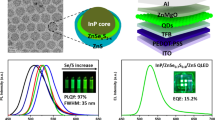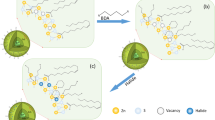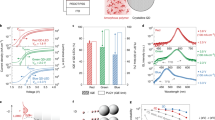Abstract
Green indium phosphide (InP)-based quantum dot light-emitting diodes (QD-LEDs) still suffer from low efficiency and short operational lifetime, posing a critical challenge to fully cadmium-free QD-LED displays and lighting1,2,3. Unfortunately, the factors that underlie these limitations remain unclear and, therefore, no clear device-engineering guidelines are available. Here, by using electrically excited transient absorption spectroscopy, we find that the low efficiency of state-of-the-art green cadmium-free QD-LEDs (which ubiquitously adopt the InP–ZnSeS–ZnS core–shell–shell structure) originates from the ZnSeS interlayer because it imposes a high injection barrier that limits the electron concentration and trap saturation. We demonstrate, both experimentally and theoretically, that replacing the currently widely used ZnSeS interlayer with a thickened ZnSe interlayer enables improved electron injection and depressed leakage simultaneously, allowing to achieve a peak external quantum efficiency of 26.68% and T95 lifetime (time for the luminance to drop to 95% of the initial value) of 1,241 h at an initial brightness of 1,000 cd m–2 in green InP-based QD-LEDs emitting at 543 nm—exceeding the previous best values by a factor of 1.6 and 165, respectively3,4.
This is a preview of subscription content, access via your institution
Access options
Access Nature and 54 other Nature Portfolio journals
Get Nature+, our best-value online-access subscription
27,99 € / 30 days
cancel any time
Subscribe to this journal
Receive 51 print issues and online access
199,00 € per year
only 3,90 € per issue
Buy this article
- Purchase on SpringerLink
- Instant access to full article PDF
Prices may be subject to local taxes which are calculated during checkout




Similar content being viewed by others
Data availability
The data that support the findings of this study are available in the article and its Supplementary Information. All other relevant data are available from the corresponding authors upon reasonable request. Additional data are available on Figshare at https://doi.org/10.6084/m9.figshare.27682983 (ref. 43). Source data are provided with this paper.
Code availability
The code that supports the findings of this study is available from the corresponding authors upon reasonable request.
References
Won, Y.-H. et al. Highly efficient and stable InP/ZnSe/ZnS quantum dot light-emitting diodes. Nature 575, 634–638 (2019).
Kim, T. et al. Efficient and stable blue quantum dot light-emitting diode. Nature 586, 385–389 (2020).
Chao, W.-C. et al. High efficiency green InP quantum dot light-emitting diodes by balancing electron and hole mobility. Commun. Mater. 2, 96 (2021).
Wu, Q. et al. Quasi‐shell‐growth strategy achieves stable and efficient green InP quantum dot light‐emitting diodes. Adv. Sci. 9, 2200959 (2022).
Colvin, V. L., Schlamp, M. C. & Alivisatos, A. P. Light-emitting diodes made from cadmium selenide nanocrystals and a semiconducting polymer. Nature 370, 354–357 (1994).
Coe, S., Woo, W.-K., Bawendi, M. & Bulović, V. Electroluminescence from single monolayers of nanocrystals in molecular organic devices. Nature 420, 800–803 (2002).
Dai, X. et al. Solution-processed, high-performance light-emitting diodes based on quantum dots. Nature 515, 96–99 (2014).
García de Arquer, F. P. et al. Semiconductor quantum dots: technological progress and future challenges. Science 373, eaaz8541 (2021).
Deng, Y. et al. Solution-processed green and blue quantum-dot light-emitting diodes with eliminated charge leakage. Nat. Photon. 16, 505–511 (2022).
Xu, H. et al. Dipole–dipole-interaction-assisted self-assembly of quantum dots for highly efficient light-emitting diodes. Nat. Photon. 18, 186–191 (2024).
Meng, T. et al. Ultrahigh-resolution quantum-dot light-emitting diodes. Nat. Photon. 16, 297–303 (2022).
Dai, X., Deng, Y., Peng, X. & Jin, Y. Quantum‐dot light‐emitting diodes for large‐area displays: towards the dawn of commercialization. Adv. Mater. 29, 1607022 (2017).
Madelung, O. Semiconductors: Group IV Elements and III-V Compounds (Springer Science & Business Media, 2012).
Yu, P. et al. Highly efficient green InP-based quantum dot light-emitting diodes regulated by inner alloyed shell component. Light Sci. Appl. 11, 162 (2022).
Li, B., Tang, B., Fan, F. & Du, J. Transient absorption spectrometer using excitation by pulse current. CN Patent CN112683797B (2021).
Gao, Y. et al. Minimizing heat generation in quantum dot light-emitting diodes by increasing quasi-Fermi-level splitting. Nat. Nanotechnol. 18, 1168–1174 (2023).
Klimov, V. I., Mikhailovsky, A. A., McBranch, D., Leatherdale, C. A. & Bawendi, M. G. Quantization of multiparticle Auger rates in semiconductor quantum dots. Science 287, 1011–1013 (2000).
Klimov, V. I. Optical nonlinearities and ultrafast carrier dynamics in semiconductor nanocrystals. J. Phys. Chem. B 104, 6112–6123 (2000).
Livache, C. et al. High-efficiency photoemission from magnetically doped quantum dots driven by multi-step spin-exchange Auger ionization. Nat. Photon. 16, 433–440 (2022).
Karpov, S. ABC-model for interpretation of internal quantum efficiency and its droop in III-nitride LEDs: a review. Opt. Quantum Electron. 47, 1293–1303 (2015).
Ishioka, K., Barker, B. G. Jr, Yanagida, M., Shirai, Y. & Miyano, K. Direct observation of ultrafast hole injection from lead halide perovskite by differential transient transmission spectroscopy. J. Phys. Chem. Lett. 8, 3902–3907 (2017).
Yang, K., East, J. R. & Haddad, G. I. Numerical modeling of abrupt heterojunctions using a thermionic-field emission boundary condition. Solid State Electron. 36, 321–330 (1993).
Walker, A., Kambili, A. & Martin, S. Electrical transport modelling in organic electroluminescent devices. J. Phys. Condens. Matter 14, 9825 (2002).
Jung, S.-M. et al. Modelling charge transport and electro-optical characteristics of quantum dot light-emitting diodes. npj Comput. Mater. 7, 122 (2021).
Burrows, P. & Forrest, S. Electroluminescence from trap‐limited current transport in vacuum deposited organic light emitting devices. Appl. Phys. Lett. 64, 2285–2287 (1994).
Scholz, S., Kondakov, D., Lussem, B. & Leo, K. Degradation mechanisms and reactions in organic light-emitting devices. Chem. Rev. 115, 8449–8503 (2015).
Mude, N. N., Khan, Y., Thuy, T. T., Walker, B. & Kwon, J. H. Stable ZnS electron transport layer for high-performance inverted cadmium-free quantum dot light-emitting diodes. ACS Appl. Mater. Interfaces 14, 55925–55932 (2022).
Zhang, H. et al. High-efficiency green InP quantum dot-based electroluminescent device comprising thick-shell quantum dots. Adv. Opt. Mater. 7, 1801602 (2019).
Moon, H. et al. Composition-tailored ZnMgO nanoparticles for electron transport layers of highly efficient and bright InP-based quantum dot light emitting diodes. Chem. Commun. 55, 13299–13302 (2019).
Iwasaki, Y., Motomura, G., Ogura, K. & Tsuzuki, T. Efficient green InP quantum dot light-emitting diodes using suitable organic electron-transporting materials. Appl. Phys. Lett. 117, 111104 (2020).
Gao, P., Zhang, Y., Qi, P. & Chen, S. Efficient InP green quantum-dot light-emitting diodes based on organic electron transport layer. Adv. Opt. Mater. 10, 2202066 (2022).
Li, L. et al. Efficient and bright green InP quantum dot light-emitting diodes enabled by a self-assembled dipole interface monolayer. Nanoscale 15, 2837–2842 (2023).
Zhang, T. et al. Understanding and hindering the electron leakage in green InP quantum-dot light-emitting diodes. Adv. Photon. Res. 4, 2300146 (2023).
Wu, Q. et al. Bridging chloride anions enables efficient and stable InP green quantum-dot light-emitting diodes. Adv. Opt. Mater. 11, 2300659 (2023).
Shin, S. et al. Fluoride-free synthesis strategy for luminescent InP cores and effective shelling processes via combinational precursor chemistry. Chem. Eng. J. 466, 143223 (2023).
Wang, L., Fan, Z., Liu, D., Zhang, Z. & Zou, B. Modified charge injection in green InP quantum dot light-emitting diodes utilizing a plasma-enhanced NiO buffer layer. J. Phys. Chem. C 128, 3985–3993 (2024).
Zhang, T. et al. Electric dipole modulation for boosting carrier recombination in green InP QLEDs under strong electron injection. Nanoscale Adv. 5, 385–392 (2023).
Wang, Y. et al. Boosting the efficiency and stability of green InP quantum dot light emitting diodes by interface dipole modulation. J. Mater. Chem. C 10, 8192 (2022).
Taylor, D. A. et al. Importance of surface functionalization and purification for narrow FWHM and bright green-emitting InP core-multishell quantum dots via a two-step growth process. Chem. Mater. 33, 4399–4407 (2021).
Hunsche, S., Dekorsy, T., Klimov, V. & Kurz, H. Ultrafast dynamics of carrier-induced absorption changes in highly-excited CdSe nanocrystals. Appl. Phys. B 62, 3–10 (1996).
Kumar, B., Campbell, S. A. & Paul Ruden, P. Modeling charge transport in quantum dot light emitting devices with NiO and ZnO transport layers and Si quantum dots. J. Appl. Phys. 114, 044507 (2013).
Gao, X. & Yee, S. S. Hole capture cross section and emission coefficient of defect centers related to high-field-induced positive charges in SiO2 layers. Solid State Electron. 39, 399–403 (1996).
Bian, Y. et al. Datasets for ‘Efficient green InP-based QD-LED by controlling electron injection and leakage’. Figshare https://doi.org/10.6084/m9.figshare.27682983 (2024).
Lee, T. et al. Highly efficient and bright inverted top-emitting InP quantum dot light-emitting diodes introducing a hole-suppressing interlayer. Small 15, 1905162 (2019).
Kim, J. et al. Realization of highly efficient InP quantum dot light-emitting diodes through in-depth investigation of exciton-harvesting layers. Adv. Opt. Mater. 11, 2300088 (2023).
Lee, S. H. et al. ZnSeTe quantum dots as an alternative to InP and their high-efficiency electroluminescence. Chem. Mater. 32, 5768–5775 (2020).
Yoon, S. Y. et al. Highly emissive green ZnSeTe quantum dots: effects of core size on their optical properties and comparison with InP counterparts. ACS Energy Lett. 8, 1131–1140 (2023).
Sun, L. et al. Efficient and stable multi‐color emissions of the coumarin modified Cs3LnCl6 lead‐free perovskite nanocrystals and led application. Adv. Mater. 36, 2310065 (2024).
Acknowledgements
We acknowledge financial support from the National Natural Science Foundation of China (grant nos. U22A2072, 52272167 and 62204078), Innovation Program for Quantum Science and Technology (grant no. 2021ZD0301603), Fundamental Research Funds for the Central Universities, the National Key R&D Program of China (grant nos. 2023YFE0205000 and 2022YFB3602901), Zhongyuan High Level Talents Special Support Plan (grant no. 244200510009), the Beijing Natural Science Foundation (grant no. Z220007) and the Postdoctoral Fellowship Program (Grade C) of the China Postdoctoral Science Foundation (grant no. GZC20240386).
Author information
Authors and Affiliations
Contributions
F.F. and H.S. conceived the concept and designed the experiments. H.S., F.F., A.T. and F.C. supervised the project. Y.B. and X.Y. contributed equally. Y.B. and Q.L. synthesized the materials. F.C., S.W., H.Z., W.Z. and D.Z. fabricated the devices and collected the performance data of the QD-LEDs. X.Y. conducted the EETA experiments and developed the tunnelling model. Z.L. and W.H. collected the operational lifetime data of the QD-LEDs. Y.B., X.Y., F.C., B.L., F.F. and H.S. conducted the data analysis and wrote the manuscript. All authors contributed to the scientific discussion and modified the manuscript.
Corresponding authors
Ethics declarations
Competing interests
The authors declare no competing interests.
Peer review
Peer review information
Nature thanks Eunjoo Jang and the other, anonymous, reviewer(s) for their contribution to the peer review of this work. Peer reviewer reports are available.
Additional information
Publisher’s note Springer Nature remains neutral with regard to jurisdictional claims in published maps and institutional affiliations.
Extended data figures and tables
Extended Data Fig. 1 PETA and EETA spectra of Cd-based QD-LEDs.
PETA spectra of QD-LEDs based on (a) 636 nm (ZnCdSe/ZnSeS), (b) 529 nm (CdSeS/ZnSe/ZnS) and (c) 473 nm (ZnCdSe/ZnSe/ZnS) core/shell QDs. EETA spectra of QD-LEDs based on (d) 636 nm (ZnCdSe/ZnSeS), (e) 529 nm (CdSeS/ZnSe/ZnS) and (f) 473 nm (ZnCdSe/ZnSe/ZnS) core/shell QDs.
Extended Data Fig. 2 Characterizations of high-performance QD-LEDs based on 636 nm, 529 nm and 473 nm Cd-based QDs.
a, d, g, Current density-luminance-voltage (J–L–V) characteristics. b, e, h, EQE and current efficiency (ηA) as functions of luminance for those devices. c, f, i, EL spectra versus voltage profiles.
Extended Data Fig. 3 PETA and EETA spectra on InP-based QD-LEDs.
PETA spectra of QD-LEDs based on (a) 615 nm, (c) 593 nm, (e) 560 nm and (g) 540 nm InP/ZnSeS/ZnS core/shell QDs. EETA spectra of QD-LEDs based on (b) 615 nm, (d) 593 nm, (f) 560 nm and (h) 540 nm InP/ZnSeS/ZnS core/shell QDs.
Extended Data Fig. 4 Characterizations of QD-LEDs based on 615 nm and 540 nm InP/ZnSeS/ZnS QDs.
a, d, J–L–V characteristics. b, e, EQE and ηA as functions of luminance for those devices. c, f, EL spectra versus voltage profiles.
Extended Data Fig. 5 Characterizations of InP/ZnSeS/ZnS QDs and InP-based QD-LEDs with different ZnS proportions in the ZnSeS interlayer shell.
a, Absorbance and PL spectra. b, FWHM (left axis) and PL QY (right axis). c, X-ray diffraction pattern. d, J–L–V characteristics. e, EQE and ηA as functions of luminance for those devices.
Extended Data Fig. 6 Characterizations of InP/ZnSe/ZnS QDs and QD-LEDs with different ZnSe thicknesses.
a, Absorbance and PL spectra. b, FWHM (left axis) and PL QY (right axis). c, X-ray diffraction pattern. TEM images of InP/ZnSe/ZnS QDs with different ZnSe thicknesses (2.5 nm, 3.3 nm, 4.0 nm, 4.5 nm). e, J–L–V characteristics. f, EQE and ηA as functions of luminance for those devices.
Extended Data Fig. 8 Operational lifetimes characterizations of QD-LEDs.
The operational lifetimes (actual luminance/initial luminance (L/L0) versus time) of QD-LEDs based on (a) InP/ZnSeS/ZnS, (b) InP/ZnSe (2.5 nm)/ZnS, (c) InP/ZnSe (3.3 nm)/ZnS and (d) InP/ZnSe (4.5 nm)/ZnS. The lifetimes (T95) at various initial luminance (L0) values are shown in the insets. The acceleration factors (n) are fitted according to the empirical relationship of L0n • T = constant.
Supplementary information
Supplementary Information
Supplementary Figs. 1–14 and Tables 1–6.
Source data
Rights and permissions
Springer Nature or its licensor (e.g. a society or other partner) holds exclusive rights to this article under a publishing agreement with the author(s) or other rightsholder(s); author self-archiving of the accepted manuscript version of this article is solely governed by the terms of such publishing agreement and applicable law.
About this article
Cite this article
Bian, Y., Yan, X., Chen, F. et al. Efficient green InP-based QD-LED by controlling electron injection and leakage. Nature 635, 854–859 (2024). https://doi.org/10.1038/s41586-024-08197-z
Received:
Accepted:
Published:
Issue Date:
DOI: https://doi.org/10.1038/s41586-024-08197-z
This article is cited by
-
Highly efficient light-emitting diodes via self-assembled InP quantum dots
Nature Communications (2025)
-
Highly efficient and eco-friendly green quantum dot light-emitting diodes through interfacial potential grading
Nature Communications (2025)



